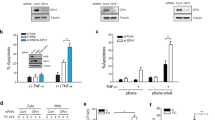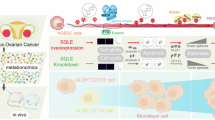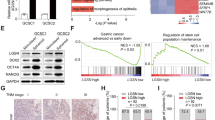Abstract
Oxyradicals are involved in multiple mutational events and can contribute to the conversion of healthy cells to cancer cells. Glutathione (GSH) and the GSH-replenishing enzymes keep the antioxidant status of normal cells at a level where they can avert oxyradical derived mutations. The aim of this study was to determine whether in cancer cells the GSH-replenishing, GSH antioxidant and GSH-depleting enzymes were not at appropriate levels and therefore not able to protect cancer cells adequately against oxyradical-induced mutations. Cancer of the oesophagus was chosen since it is the most common gastrointestinal malignancy in South African Blacks. Biopsies and blood from 31 patients with cancer of the oesophagus and 29 non-cancer patients were assessed for these enzymes. The mean activity of the antioxidant and depleting enzyme GSH-peroxidase was elevated significantly by twofold in the cancer tissue compared to normal tissue. However, the activity of the replenishing enzyme GSSG-reductase and the level of the depleting enzyme GSH-s-transferase P1-isoenzyme were significantly reduced by 23% and 33% respectively. As in a previous paper we found that GSH was depleted and γ-glutamine transpeptidase was diminished in oesophageal cancer. There can be two reasons for GSH depletion. Firstly, elevated GSH–peroxidase will use more GSH in an attempt to cope with the excessive production of oxyradicals as revealed by elevated lipid peroxidation; this was, as shown by us before, elevated sixfold in oesophageal cancer. Secondly, if little replenishment of GSH occurred the level of GSH would become lower. This was confirmed by our findings that the activities of the replenishing enzymes were significantly diminished in oesophageal cancer tissue. Contrary to what was expected, the other depleting enzyme GSH-s-transferase P1 was not elevated in cancer tissue but was significantly lower. However, in the blood of the same patients it was significantly elevated. An explanation for this phenomenon is that, although the production of GST-P1 was enhanced in cancer, it did not show because it was rapidly extruded into the blood by an unknown mechanism operational only in cancer cells.
Similar content being viewed by others
Article PDF
Change history
16 November 2011
This paper was modified 12 months after initial publication to switch to Creative Commons licence terms, as noted at publication
References
Ames, B. N., Shigenaga, M. K. & Hagen, T. M. (1993) Oxidants, antioxidants, and the degenerative disease of ageing. Proc Natl Acad Sci USA 90: 7915–7922.
Basu, A. K. & Marnett, L. J. (1983) Unequivocal demonstration that malondialdehyde is a mutagen. Carcinogenesis 4: 331–334.
Beutler, E. (1969) Effect of flavin compounds on glutathione reductase activity: in vivo and in vitro studies. J Clin Invest 48: 1957–1966.
Bhuvarahamurthy, V., Balasubramanian, N. & Govindasamy, S. (1996) Effect of radio- and chemotherapy on circulating antioxidant-system of human uterine cervical carcinoma. Mol Cell Biochem 158: 17–23.
Brockmöller, J., Kerb, R., Drakoulis, N., Nitz, M. & Roots, I. (1993) Genotype and phenotype of glutathione s-transferase class μ isoenzymes μ and ψ in lung cancer patients and controls. Cancer Res 53: 1004–1011.
Campbell, J. A. H., Corrigall, A. V., Guy, A. & Kirsch, R. E. (1991) Immunohistologic localization of Alpha, Mu, and Pi class glutathione s-transferases in human tissues. Cancer 67: 1608–1613.
Chen, J., Geissler, C., Parpia, B., Li, J. & Campbell, T. C. (1992) Antioxidant status and cancer mortality in China. Int J Epidemiol 21: 625–635.
Crawford, D., Amstad, P., Zbindin, I. & Cerutti, P. (1988) Oxidant stress induces the proto-oncogenes c-fos and c-myc in mouse epidermal cells. Oncogene 3: 27–32.
Durak, I., Bayram, F., Kavutcu, M., Canbolat, O. & Ozturk, H. S. (1996) Impaired enzymatic antioxidant defense mechanism in cancerous human thyroid tissues. J Endocrinol Invest 19: 312–315.
El-Sharabasy, M. M. H., El-Dosoky, I., Horria, H. & Khalaf, A. H. (1993) Elevation of glutathione, glutathione-reductase and nucleic acids in both normal tissues and tumour of breast cancer patients. Cancer Lett 72: 11–15.
Eriksson, L. C. & Andersson, G. N. (1992) Membrane biochemistry and chemical hepatocarcinogenesis. Crit Rev Biochem Mol Biol 27: 1–55.
Fan, K. C., Huang, Y. C. & Li, C. H. (1995) Radioimmunoassay for plasma glutathione S-transferase-pi and its clinical application in gastrointestinal cancer. Cancer 76: 1363–1367.
Flohé, L. & Günzler, W. A. (1984) Assays of glutathione peroxidase. Methods Enzymol 105: 114–121.
Floyd, R. A. (1990) The role of 8-hydroxyguanine in carcinogenesis. Carcinogenesis 11: 1447–1450.
Gajewska, J. & Szczypka, M. (1992) Role of pi form of glutathione s-transferase (GST-pi) in cancer: a minireview. Mater Med Pol 24: 45–49.
Guyton, K. Z. & Kensler, T. W. (1993) Oxidative mechanisms in carcinogenesis. Br Med Bull 49: 523–544.
Halliwell, B. & Gutteridge, J. M. C. (1992) Biologically relevant metal ion-dependent hydroxyl radical generation. FEBS Lett 307: 108–112.
Hayes, J. D. & Pulford, D. J. (1995) The glutathione s-transferase supergene family: regulation of GST and the contribution of the isoenzymes to cancer chemoprotection and drug resistance. Crit Rev Biochem Mol Biol 30: 445–600.
Howie, A. F., Douglas, J. G., Fergusson, R. J. & Beckett, G. J. (1990) Measurement of glutathione s-transferase Pi isoenzyme in plasma, a possible marker for adenocarcinoma of the lung. Clin Chem 36: 453–456.
Hunter, S. J. S., Richards, G. A., Oosthuizen, M. M. J. & Bremner, C. G. (1992) Glutathione, glutathione s-transferase and gamma-glutamyl transpeptidase levels in squamous cell carcinoma of the esophagus. Res Surg 4: 160–164.
Ishioka, C., Kanamaru, R., Shibata, H., Konishi, Y., Ishikawa, A., Wakui, A., Sato, T. & Nishihira, T. (1991) Expression of glutathione s-transferase-π messenger RNA in human esophageal cancers. Cancer 67: 2560–2564.
Jendryczko, A., Pardela, M. & Kozlowski, A. (1993) Erythrocyte glutathione peroxidase in patients with colon cancer. Neoplasma 40: 107–109.
Kasai, H. & Nishimura, S. (1991). Formation of 8-hydroxydeoxyguanosine in DNA by oxygen radicals and its biological significance. In Oxidative Stress: Oxidants and Antioxidants, H Sies (Ed), pp. 99–116. Academic Press: London
Kura, T., Takahashi, Y., Takayama, T., Ban, N., Saito, T., Kuga, T. & Niitsu, Y. (1996) Glutathione s-transferase-π is secreted as a monomer into human plasma by platelets and tumor cells. Biochim Biophys Acta 1292: 317–323.
Levy, R. D., Oosthuizen, M. M. J., Degiannis, E. & Lambrechts, H. (1998) Elevated reversible and irreversible lipid peroxidation in human oesophageal cancer. Anticancer Res 18: 1325–1328.
Lowry, O. H., Rosebrough, N. J., Farr, A. L. & Randall, R. J. (1951) Protein measurement with the Folin phenol reagent. J Biol Chem 193: 265–275.
Masotti, L., Casali, E., Gesmundo, N., Sartor, G., Galeotti, T., Borrello, S., Piretti, M. V. & Paglinca, G. (1988) Lipid peroxidation in cancer cells: chemical and physical studies. Ann N Y Acad Sci 551: 47–57.
Miura, K., Suzuki, S., Tanita, J., Shinkawa, H., Satoh, K. & Tsuchida, S. (1997) Correlated expression of glutathione s-transferase-pi and c-Jun or other oncogene products in human squamous cell carcinomas of the head and neck: relevance to relapse after radiation therapy. Jpn J Cancer Res 88: 143–151.
Mukai, F. H. & Goldstein, B. D. (1975) Mutagenicity of malondialdehyde, a decomposition product of peroxidized polyunsaturated fatty acids. Science 191: 868–869.
Mulder, T. P., Manni, J. J., Roelofs, H. M., Peters, W. H. & Wiersma, A. (1995) Glutathione peroxidases in human head and neck cancer. Acta Otolaryngol 115: 331–333.
Niitsu, Y., Takahashi, Y., Saito, T., Hirata, Y., Arisato, N., Maruyama, H., Kohgo, Y. & Listowsky, I. (1989) Serum glutathione-s-transferase-π as a tumor marker for gastrointestinal malignancies. Cancer 63: 317–323.
Peters, W. H. M., Wormskamp, N. G. M. & Thies, E. (1990) Expression of glutathione s-transferases in normal gastric mucosa and in gastric tumors. Carcinogenesis 11: 1593–1596.
Peters, W. H. M., Wobbes, T., Roelofs, H. M. J. & Jansen, JBMJ (1993) Glutathione s-transferases in esophageal cancer. Carcinogenesis 14: 1377–1380.
Rees, G. W., Trull, A. K. & Doyle, S. (1995) Evaluation of an enzyme-immunometric assay for serum α-glutathione s-transferase. Ann Clin Biochem 32: 575–583.
Ribeiro, U., Safatle-Ribeiro, A. V., Posner, M. C., Rosendale, B., Bakker, A., Swalsky, P. A., Kim, R., Reynolds, J. C. & Finkelstein, S. D. (1996) Comparative p53 mutational analysis of multiple primary cancers of the upper aerodigestive tract. Surgery 120: 45–53.
Sasano, H., Miuazaki, S., Shiga, K., Goukon, Y., Nishihira, T. & Nagura, H. (1993) Glutathione s-transferase in human esophageal carcinoma. Anticancer Res 13: 363–368.
Sevanian, A., Muakkassah-Kelly, S. F. & Montrestrugue, S. (1983) The influence of phospholipase A2 and glutathione peroxidase on the elimination of membrane lipid peroxides. Arch Biochem Biophys 223: 441–452.
Simmons, T. W. & Jamall, I. S. (1988) Significance of alterations in hepatic antioxidant enzymes. Biochem J 251: 913–917.
Theologides, A., Ingersoll-Stroubos, A. M. & Apple, F. S. (1994) TNF-alpha effect on oxygen free radical scavenging and generating enzymes in rat liver. Biochem Mol Biol Int 33: 205–210.
Tsuchida, S. & Sato, K. (1992) Glutathione transferases and cancer. Crit Rev Biochem Mol Biol 27: 337–384.
Tsuchida, S., Sekine, Y., Shineha, R., Nishihira, T. & Sato, K. (1989) Elevation of the placental glutathione s-transferase from (GST-π) in tumour tissues and the levels in sera of patients with cancer. Cancer Res 49: 5225–5229.
Vaubourdolle, M., Chazouillè, V., Lasnier, E., Serfaty, I., Giboudeau, J. & Poupon, R. (1996) Plasma π-glutathione S-transferase as a marker of biliary cell damage. Hepatology 24: 593A
Vistisen, K., Priemé, H., Okkels, H., Vallentin, S., Loft, S., Olsen, J. H. & Poulsen, H. E. (1997) Genotype and phenotype of glutathione s-transferase-μ in testicular cancer patients. Pharmacogenetics 7: 21–25.
Wagner, J. R., Hu, C-C & Ames, B. N. (1992) Endogenous oxidative damage of deoxycytidine in DNA. Proc Natl Acad Sci USA 89: 3380–3384.
Wasowicz, W., Gromadzinska, J., Sklodowska, M. & Popadiuk, S. (1994) Selenium concentration and glutathione peroxidase activity in blood of children with cancer. J Trace Elem Electrolytes Health Dis 8: 53–57.
Author information
Authors and Affiliations
Rights and permissions
From twelve months after its original publication, this work is licensed under the Creative Commons Attribution-NonCommercial-Share Alike 3.0 Unported License. To view a copy of this license, visit http://creativecommons.org/licenses/by-nc-sa/3.0/
About this article
Cite this article
Levy, R., Oosthuizen, M., Degiannis, E. et al. Glutathione-linked enzymes in benign and malignant oesophageal tissue. Br J Cancer 80, 32–37 (1999). https://doi.org/10.1038/sj.bjc.6690317
Received:
Revised:
Accepted:
Published:
Issue date:
DOI: https://doi.org/10.1038/sj.bjc.6690317
Keywords
This article is cited by
-
Molecular mechanisms associated with chemoresistance in esophageal cancer
Cellular and Molecular Life Sciences (2022)



